This is a Kodak Regent, a folding rangefinder roll film camera made in Stuttgart, Germany by Kodak AG starting in 1935. The Regent natively shoots eight 6cm x 9cm images on 620 roll film or with the use of a mask, sixteen 4.5cm x 6cm images. The Regent was a high end camera with a coupled coincident image rangefinder and came with a selection of top quality Schneider-Kreuznach or Zeiss lenses. The Regent was one of only a few cameras not made in the United States to use Kodak’s 620 film format. An updated Regent II was later offered with a redesigned all metal top plate and removed the ability to use the half frame baffle, and also used regular 120 film, instead of Kodak’s 620 format.
Film Type: 620 Roll Film (eight 6cm x 9cm or sixteen 4.5cm x 6cm exposures per roll)
Lens: 10.5cm f/4.5 Schneider-Kreuznach Xenar uncoated 4-elements in 3-groups
Focus: 1 meter to Infinity
Viewfinder: Flip up Optical Scale Focus and Separate Coincident Image Coupled Rangefinder
Shutter: Compur Leaf
Speeds: T, B, 1 – 1/250 seconds
Exposure Meter: None
Battery: None
Flash Mount: None
Weight: 783 grams
Manual: None
How these ratings work |
The Kodak Regent was a sleek and innovative camera built alongside many other high quality Kodak cameras in Stuttgart Germany. Featuring a coincident image coupled rangefinder inside of an aluminum and leather body with high quality lenses and shutters, and supporting both 6×9 and 4.5×6 images, the Regent should have been a rousing success, but it wasn’t. The camera was expensive to build and sell, was not exported to the United States, and was in production for a very short period of time. The Regent is very hard to find today, but if you can get your hands on one, they are well worth adding to your collection. | ||||||
| Images | Handling | Features | Viewfinder | Feel & Beauty | History | Age | |
| 2 | 0 | 2 | 1 | 2 | 1 | 40% | |
| Bonus | none | ||||||
| Final Score | 11.2 | ||||||
History
There is no shortage of information on my site or elsewhere online on the history of Dr. August Nagel. From his earliest Contessa cameras to his various mergers, first with Nettel and then later Zeiss-Ikon, August Nagel was already respected before his employment by Kodak in 1931.
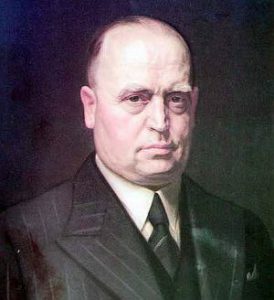
After leaving Zeiss-Ikon in 1928 to form Nagel Werke, August Nagel created a large number of new cameras such as the Vollenda, Pupille, Librette, and Recomar. In a short period of time, Nagel had proven he could still be successful without the benefit or resources of a large firm like Zeiss-Ikon, but despite his accolades and success at making quality cameras, the German economy was still poor and political changes were on the rise, both of which held back Nagel’s ability to continue to innovate.
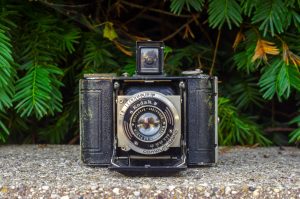
Conveniently, around this time Kodak was looking to improve their reputation in the camera industry by offering a lineup of German designed cameras bearing the Kodak name. In 1931, representatives from Kodak offered to merge with Nagel Werke giving them the capital and support of one of the largest photographic companies in the world, with the understanding that August Nagel would remain as Managing Director and Chief Designer of the new Kodak / Nagel AG. Nagel would retain his title and stature from his own company while having the creative freedom to continue to develop and release his own models while working for Kodak. It was a win win for both Kodak and Nagel. In December 1931, the merger was completed for an undisclosed amount of money, and with Nagel Werke’s merger into Kodak, came most of Nagel’s earlier models like the Pupille, Vollenda, and Recomar. Most of these models would be sold under the Kodak name, but would otherwise be unchanged.
While working on these new models, most of Nagel’s earlier models would remain on sale until the late 1930s relatively unchanged other than being branded as Kodak, instead of Nagel cameras. For the models like the Vollenda, the collector’s value of an original non-Kodak Nagel branded version is always higher. But despite any variance in collector’s price, the quality of the cameras was the same between the pre and post-Kodak days.
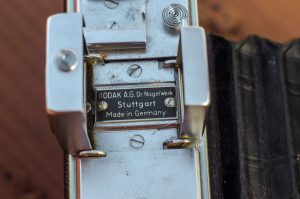
After joining Kodak, Nagel would begin working on two new models, the Kodak Duo Six-20 which would be their first all new model designed to use the company’s new 620 film, and the Kodak Retina, which would introduce the world to Kodak’s new 135 format film. The first Retina, known today as the Type 117, was released in 1934 and would launch a successful family of Retina cameras that would be produced in Germany through the early 1970s. A huge number of folding, non-folding, rangefinder, and SLR models would be sold over the next 25 or so years, helping to elevate Kodak’s stance as a world class camera maker.
In the same Stuttgart factory that was churning out Retinas, Duo Six-20s, and Kodak branded versions of Nagel’s early cameras, in 1935, a new camera called the Kodak Regent was released. Of all German Kodaks, the Regent is the most mysterious of all.
According to Kodak Retina historian David Jentz and former Kodak AG employee Klaus Schicht, the history of the Regent is not well told. Although produced by the same factory where other Nagel designs were made, there is no supporting evidence showing Nagel’s direct involvement with this camera. If he did, sufficient documentation has never been found.
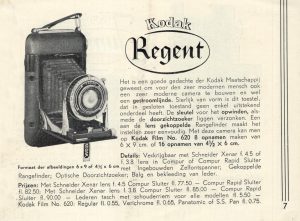
Using Kodak’s new 620 format of roll film, the Regent normally shot 6cm x 9cm images, but also came with a mask allowing for half frame 4.5cm x 6cm images. The Regent had a coupled coincident image rangefinder, cleanly built inside a curved section of the camera’s body, giving an extremely sleek appearance. The viewfinder was a separate flip up optical viewfinder that when folded shut, fit within the curved contours of the camera’s body.
The camera came with a Compur leaf shutter, and a couple of different German lenses, the most common of which is the f/4.5 Schneider-Kreuznach Xenar seen here. A slightly faster f/3.8 Xenar and a Zeiss Tessar was also available, although these seem to be far less common.
In my research for this article, I found very little info on the Kodak Regent. What little I could find all came from catalogs from European countries. I exhaustively searched every US Kodak catalog I could find in Pacific Rim’s Reference Library, Charlie Kamermann’s Kodak Collector site, and a variety of other sites that have old Kodak catalogs, and the Regent did not appear in any US catalog from the 1930s. According to Klaus Schicht, some Regents have been found with the focus scale measured in feet instead of meters, suggesting it was exported out of Europe, but to exactly which countries is unknown.
I also have my doubts about the dates that are frequently mentioned online about the camera being in production from 1935 to 1939. While the 1935 date is likely correct, I found no evidence of this camera being made after 1938. It is plausible that unsold new stock might have been available until 1939, but it does not appear that the camera was still being made. The rarity of this camera supports a shorter production run as you’d think that a camera in production for over four years would show up more often, but this is my own opinion.
Although the Kodak Regent is rare, a second model called the Regent II also existed which is even rarer, and shrouded in just as much mystery. Like the original Regent, I could not find any info on the second Regent in any US catalog, but it also doesn’t appear in any of the European ones either.
The Regent II was an almost entirely different camera sharing very little with the original Regent. Instead of an all leather covered and contoured body, the Regent II came in a more traditionally shaped folding camera body with angled corners, a chrome top plate, and chrome accents on the sides and bottom. Instead of a separate rangefinder and flip up viewfinder, the Regent II had what looked to be a combined coincident image rangefinder.
The shape and design of the folding struts on the side were completely different on the Regent II, the side mounted focus knob was replaced with a wheel on the back corner of the top plate, and the focus scale was moved from the front to the side. The back of the camera only shows a single opening for 6cm x 9cm images, suggesting the half frame 4.5cm x 6cm option was removed, and the camera added an exposure counter, a feature completely missing from the first Regent. The overall appearance of the camera somewhat resembles a much larger version of a Kodak Retina II from the same era.
Other than the name, the only real similarity between the first and second Regent models were their use of German shutters and lenses, and that they were built in Stuttgart.
When exactly the camera was produced is also up for debate as Brian Whallen’s Regent page says that both Regent models were released in 1935, but the camera-wiki page for the Regent suggests the second model came later, in 1939.

In my research for this article, I found six examples of the Regent II. Five of them, including the one above, all have Schneider Xenar lenses with serial numbers starting at 141xxxx which suggests a very late 1938/early 1939 production date. A fourth Regent II had what was clearly a much earlier Compur shutter with a serial number dating it from 1930, suggesting it had been transplanted.
While Brian Whallen’s site appears to be better researched than the camera-wiki article, I am inclined to believe that the Regent II came later as not only were it’s list of features much more advanced, but it’s cosmetics were more in line with what other 1939 German rangefinders looked like.
And that’s pretty much it. The Kodak Regent was a small blip in Kodak’s pre-war lineup. Like all Stuttgart built Kodaks, the Regent had excellent build quality, came with quality shutters and lenses, and had an innovative feature set. The camera was very beautiful in design, and there were not many other medium format cameras with coupled coincident image rangefinders in 1935 when the Regent was released, so why this good looking and innovative camera was not more heavily promoted is a mystery to me.
Today, most German built Kodaks have value. People tend to like the look and build quality of these prewar cameras, and other than age related issues, usually can be found in good working condition. The Regent is an uncommon, but not impossible to find camera, but it’s rarity means that they don’t sell for cheap. If you have a chance to pick one up for anywhere close to a price you are comfortable with, I definitely encourage it.
My Thoughts

The first time I saw a Kodak Regent, it was in the Vintage Camera Collectors group on Facebook. My friend, and fellow collector, Mike Novak posted a picture of his and I thought, wow, that’s a nice looking camera! As always happens with GAS-afflicted people such as myself, I immediately went out to see how many were available to buy. My search turned up nothing. At that time, there was not a single Kodak Regent for sale anywhere in the world, so I put it in the back of my mind that if I ever were to find one for sale, I would consider it.
About a year later, I was alerted to a lot of “folding Kodaks” that at first didn’t sound too interesting, until I noticed a curiously shaped camera laying on it’s side behind something else. Not able to recognize it at first, I took a closer look at saw the distinct round windows of the rangefinder on the Regent and promptly picked up the lot.
When the camera arrived, I was ecstatic to see that it definitely was a Regent, and in pretty good shape. The body covering was in excellent shape with only a few cosmetic blemishes. I opened the camera and saw that the lens and shutter were in just as good of shape as the body, and the shutter appeared to fire at all speeds.
The one and only casualty was the rangefinder which didn’t appear to be operable at all. While looking through the window, I could see two images, but they never moved, no matter what position the focus wheel was in. Whatever linkage existed between the camera and the rangefinder was clearly inoperable. Still, the rest of the camera appeared to be in good working order, so I eagerly put it in the queue to get used.
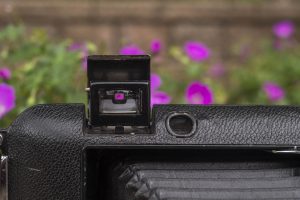
The Regent has a flip up optical viewfinder that when folded shut, is curved to match the contour of the edge of the camera. Composing images through the viewfinder is very easy as the image is large and bright. There is no provision for parallax correction like on some folding viewfinders but that’s hardly an issue as I don’t think too many people would use a Regent for close ups.

The rangefinder is a coincident image design with a fairly wide base. Its wider than a Nikon rangefinder, but not as wide as a pre-war Contax/Kiev. The rangefinder patch is very small and is magnified to only show the center of what you see in the 6×9 frame. Although you cannot compose the entire frame using the rangefinder, one of the two images has a yellow tint, making it pretty easy to use. The one on mine was not operational, but in the composite image to the right, you can get an idea of what a second image might have looked like.

In the image to the left, this side of the camera shows the film advance knob near the top, and a smaller button beneath it is the door release. Although the Regent uses a self-erecting design, the bellows must be fully extended by hand, and locked into place before using the camera.
Focusing the camera is done by rotating the small wheel at the front edge of the door, on the right side. Rotating the wheel moves the entire lens standard and shutter fore and aft.
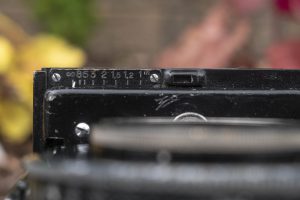
A focus scale on the front lip of the door, beneath the lens shows distances in meters only. According to his research into Nagel produced cameras, historian David Jentz confirmed that some Regents were made with focus scales in feet, but from my own observations, these are quite rare.
Although focusing the Regent is similar to other 1930s folding bed cameras, I did not like either the location of the wheel or focus scale. Assuming you had a Regent with a working rangefinder, with your eye looking through the rangefinder, the focusing wheel awkwardly faces the ground. It’s even worse if you are trying to shoot the camera in a portrait orientation as your eye is now near the bottom left with your right hand, precariously serving double duty changing the focus while supporting the camera.
Since mine had an inoperable rangefinder, I would have to regularly hold the camera at waist level to see the focusing scale on the front lip of the door, while rotating the focus wheel, and only when I had it pointing at a distance I thought was correct, would I then put my eye to the viewfinder to compose my image.
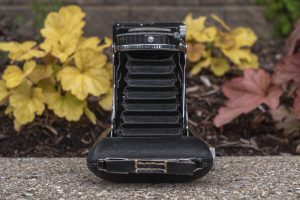
With the camera standing on it’s kickstand, the top of the shutter shows the self-timer catch. This style of Compur shutter uses the cocking lever both to cock the shutter, but also to activate the self-timer. Under normal operation, moving the cocking lever until it makes contact with the self-timer catch, will only cock the shutter. If, while moving the cocking lever, you apply backwards pressure to the self-timer catch, the cocking lever will be able to move into a second position, which activates the self-timer. Upon pressing the shutter release, the clockwork mechanism inside the shutter begins an eight to ten second delay, before the shutter fires.
From this angle, the only other thing worth mentioning is the leather strap handle on the end of the camera’s body, which in the previous image, is hiding the door release for the film compartment. Move a little lever in the direction of the arrow, and the back of the camera will swing open.
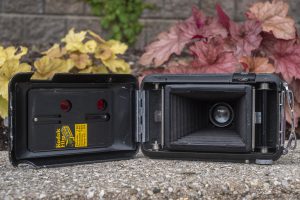
The bottom hinged film door swings open to reveal a typical 6×9 film compartment. The Regent also supports half-frame 4.5×6 images using a removeable mask that would cover up half of the 6×9 film gate, but that part was not included with my camera. Film transports from left to right onto an empty 620 spool. A clever design of the Regent’s film compartment is that unlike most folding cameras in which you have to pull up on a knob to retract the post where the spool will rest, the bottom post on the supply side, and the top post on the take up side swivel out, allowing you to easily attach the spool to the post, then swivel it back into the camera to attach it to the other side. I found this method to be far easier, and faster, than most other 120 or 620 cameras I’ve used.

I can confirm that there is not enough room for a 120 spool to fit in either the take up or supply sides of the camera. Many people who want to shoot cameras designed for 620 film will try to shave down the plastic 120 spools to make them fit, and while this usually works OK on some of Kodak’s cheaper 620 Brownies, this is something I do not recommend on their higher end cameras like the Regent. Not only do you risk damaging your film, but the jagged edges of the plastic can interfere with the film transport. Also, the center hole for a 620 spool is much smaller than that for 120, so the film will usually wobble around in it’s compartment when rotating, further causing transport problems.
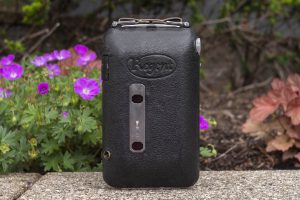
The back of the camera shows an elegant Regent logo embossed into the leather, and two red windows, one for 6×9 images and a second for 4.5×6 images. When shooting the smaller images, you must use each exposure number on the paper backing twice. The first exposure is made with the number 1 in the first window, then the second is made with the number 1 in the second window. The third is made with the number 2 in the first window and so on. The 16th and final exposure is made when the number 8 is in the second window.
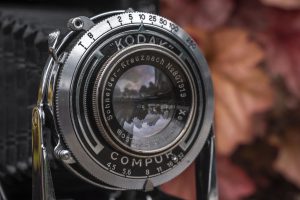
Up front, the Regent has a rim set Compur leaf shutter with speeds 1 through 1/250 plus T and B. The shutter must be cocked for all instant speeds, but not T or B. You can freely activate the shutter in either of these two settings without having to cock the shutter first.
Although the Compur’s shutter release is in the bottom corner of the shutter, the Regent has a handy linkage that wraps around the side, allowing you to fire it from a touch point near the top, right next to the cocking lever. This is very convenient and means you do not have to contort your finger around the struts trying to locate the shutter release.
Aperture is changed from f/4.5 to f/32 via a sliding tab near the bottom of the shutter. This location is typical of Compur shutters, but on the Regent, there is a large enough gap between the bottom of the shutter and the door, making changing apertures easy.
The Regent is a mixture of the usual features you’d expect to see on a pre-war 6×9 folding camera, with some nice touches from the contoured body, coupled coincident image rangefinder, swiveling film compartment posts, and shutter release relocation. It is clear that some thought and effort went into using this camera, but it was sold in very low numbers and produced for a very short period of time. Perhaps it doesn’t make good images, or does it?
Repairs
The rangefinder on my Regent didn’t work, and I made no attempt to repair it as it seemed beyond my ability, but while researching how it was done, I found these instructions on Brian Wallen’s site. I take no credit for this information as I am copying and pasting it directly here as Brian’s site no longer looks to be maintained and all the images that originally accompanied these instructions no longer work.
The Regent viewfinder is an unusual flip up design that assumes the silhouette of the body when closed. It is attached by four machine screws into the body. Both viewfinder lenses can be removed with a small slotted screw driver, by removing the hold down brackets attached through the sides of the viewfinder housing. Be sure to note the orientation of the objectives so you can reinstall them correctly. The paint on the viewfinder cover is likely to be worn and this can be renewed by removing it and with careful masking and spray painting skills. Note that to clean the rangefinder optics the viewfinder must be removed.
The rangefinder design is one of the great visual successes of the Regent. It is a separate system from the viewfinder and is tucked neatly in the contours of the top part of the body. Access to the rangefinder optics is gained by removing a panel with the camera back open. This panel is attached by two screws in the top of the film supply chamber and one small screw through the wall of the cutout in which the viewfinder sits. The mirrors of the superimposed rangefinder and the internal sides of viewing windows can be cleaned with this panel removed.
The rangefinder mechanism is attached to the focusing rack by a linkage inside the bellows compartment. The focus knob on the baseboard is geared to the rack. At the back of the rack, the focus arm slides in a channel. The upright part of the arm has a pin that engages the arm of Cam A, in this drawing, which rotates on a shaft attached to one of the rangefinder mirrors. The return action of the focus arm is controlled by the focus return spring, which sometimes gets disoriented and then loses its influence over the focus arm. In its correct orientation, the return spring must exert a backward pressure on the focus arm assembly. Rangefinder adjustment is by the screws on the focus arm.
My Results
The Kodak Regent was produced during the era in which Kodak had largely abandoned 120 roll film and used their own 620 roll film format, which is essentially the same exact film, just on a smaller spool. Although 620 has not been produced in decades, as long as you have some empty 620 spools, you can easily roll regular 120 film onto a 620 spool and use that.
Some people will try to use regular 120 spools and modify them by filing down the edges to make them smaller, but this is not something I recommend for any camera. For one, the changes of damaging the film on the spool, but also the camera with plastic shavings are just too great. But also, respooling 120 onto 620 spools takes 90 seconds to do, and is so simple that I just do not think it’s worth the risk.
For my first roll of film in the Regent in what is likely decades, I chose some lightly expired Ilford Pan F Plus, a fine grain ASA 50 speed film that I had recently picked up in a lot of other films. Although this would be my first time using this film, I felt the longevity of a slow black and white film would be a perfect match for the limited shutter speeds on the Regent.
The Kodak Regent was sold as a premium folding camera with a premium lens and premium shutter. Anyone willing to fork over whatever amount of pounds, marks, or rubies this camera cost when it was new, would have expect premium looking images, and I am happy to say that’s exactly what I got.
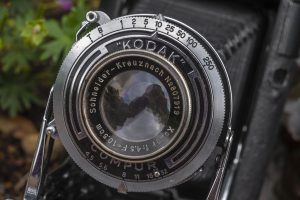
It probably should come as no surprise that any camera with a Schneider-Kreuznach Xenar lens set in a Compur shutter is going to make nice images. Sharpness in the center is excellent with only the slightest hint of softness near the edges. A very small amount of vignetting was visible in outdoor scenes where the sky was present, but I believe that’s more of a coverage issue for the 6×9 frame than any optical flaws in the lens.
The pre-war glass lacks any sort of color coating, but that didn’t seem to have any negative effect on contrast. My choice of black and white Ilford film meant that I couldn’t test the color accuracy, but I’ve shot enough pre-war uncoated lenses to predict that they likely would have been very good, with only the slightest hint at a muted color palette. The film itself was expired by about 20 years, and there are some conditional issues such as visible exposure numbers that transferred from the paper back and some marbling in the highlights, but nothing I can blame on the camera.
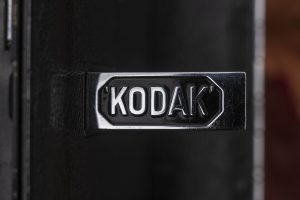
Something I’ve talked about a number of times on this site is that when using old cameras today, the results we get are likely better than any that could be had when these cameras were first made. Today, we have sharper and finer grained film than what was commonly available when many of these cameras were first produced. In addition to today’s better film, we also have the ability to make higher resolution scans that can resolve more detail than the printing methods from the 1930s could ever have done. The eight images I got from my first roll through the Kodak Regent are likely the most detailed this camera has ever made.
Using the camera was a mixed bag. While the curved body is very elegant and feels nice in the hand, the layout of the controls is not optimal. Using either the viewfinder or rangefinder with the camera in a landscape orientation, the focusing knob on the leading edge of the folding door, points towards the ground in an awkward location. This means that when trying to use the coupled rangefinder, you have to have your eye looking through the small rangefinder hole, while your left hand fumbles around the locate the small focusing knob and turn it to get the images to line up. It’s not impossible, but certainly not elegant. The camera I had for this review had an inoperable rangefinder, so I wasn’t able to use it, but even if it was working, I think I would have much preferred pre-focusing the lens and just using the regular viewfinder like I would most other rangefinder-less 6×9 folding cameras.
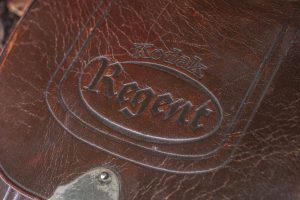
Shooting most pre-war folding cameras is a slow process, and despite it’s ambitious features, the Kodak Regent doesn’t do much to speed anything up. You can certainly get good quality images from it, but you need to take your time. The rangefinder, whether working or not, doesn’t add to the experience, and with what was likely a high price tag, probably explains why not many of these cameras were ever sold.
By far, the best feature of the Kodak Regent is it’s looks. This is a beautiful camera. The leather body covering on mine is thick and still very supple. I have no idea of who owned this camera in the three quarters of a century before I got it, but it’s pretty obvious it didn’t see a lot of use. If you are in the market for a unique camera that looks great on a shelf, the Regent is an easy recommend. If however, you want a high quality German made camera that can shoot large 6×9 images using an excellent lens, there are much better options.
Related Posts You Might Enjoy
External Links
http://camera-wiki.org/wiki/Kodak_Regent
http://www.bnphoto.org/bnphoto/KodakRegent1.htm
http://kodak.3106.net/index.php?p=217&cam=1563
https://www.rangefinderforum.com/forums/showthread.php?t=55188

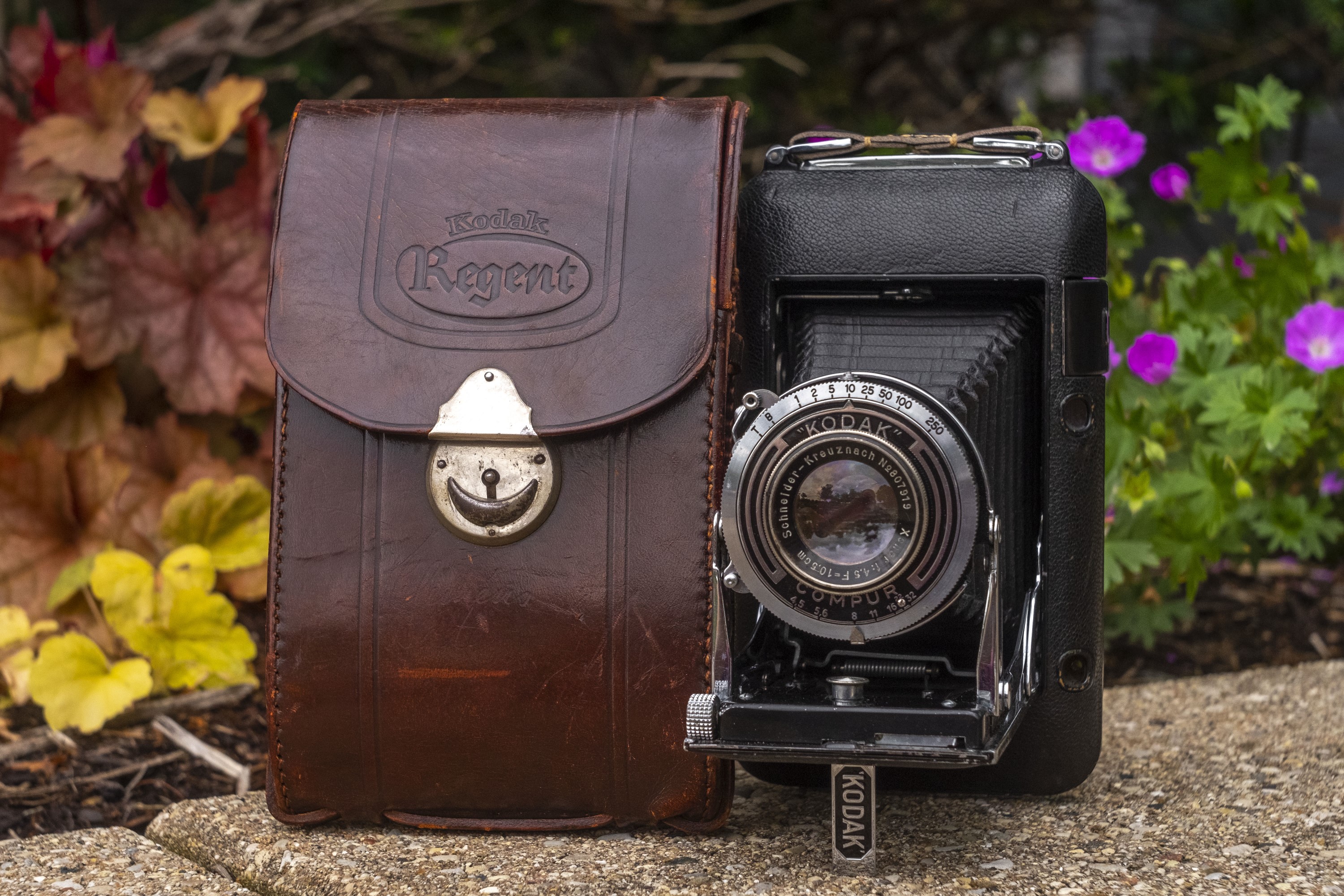
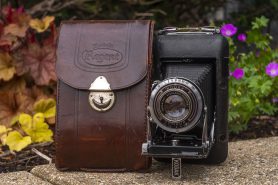

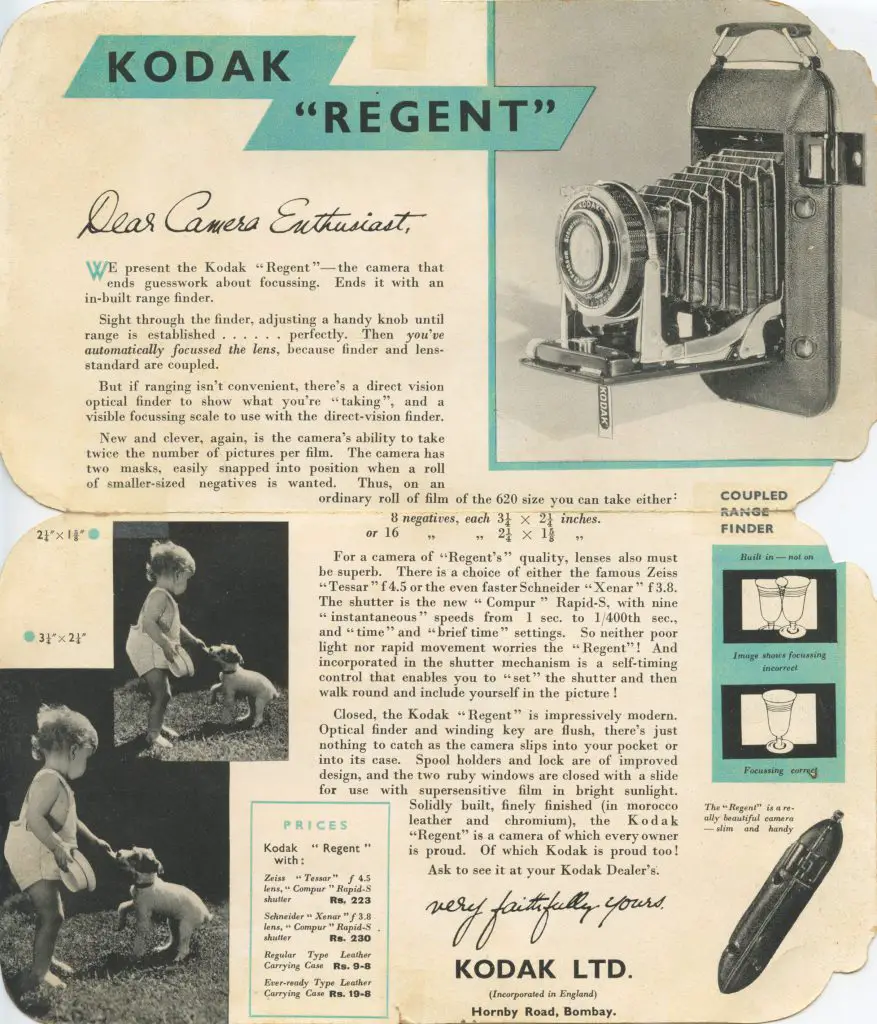
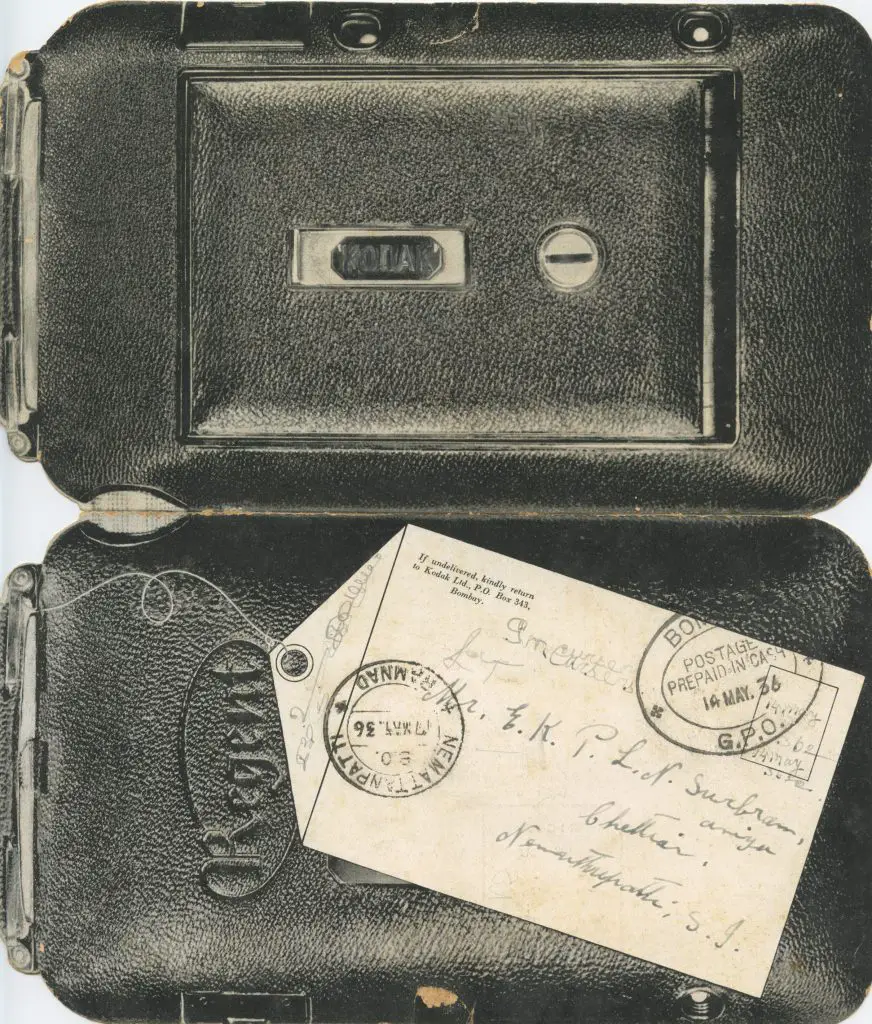
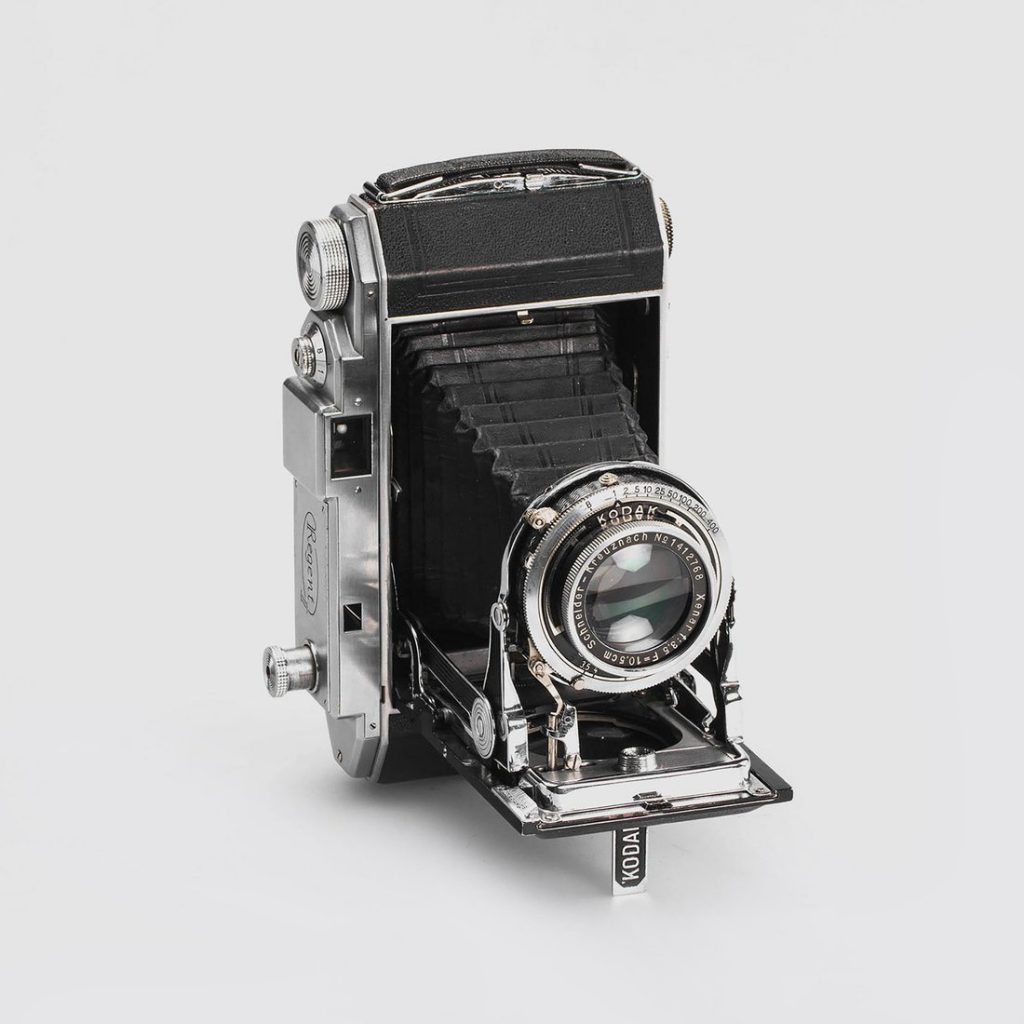
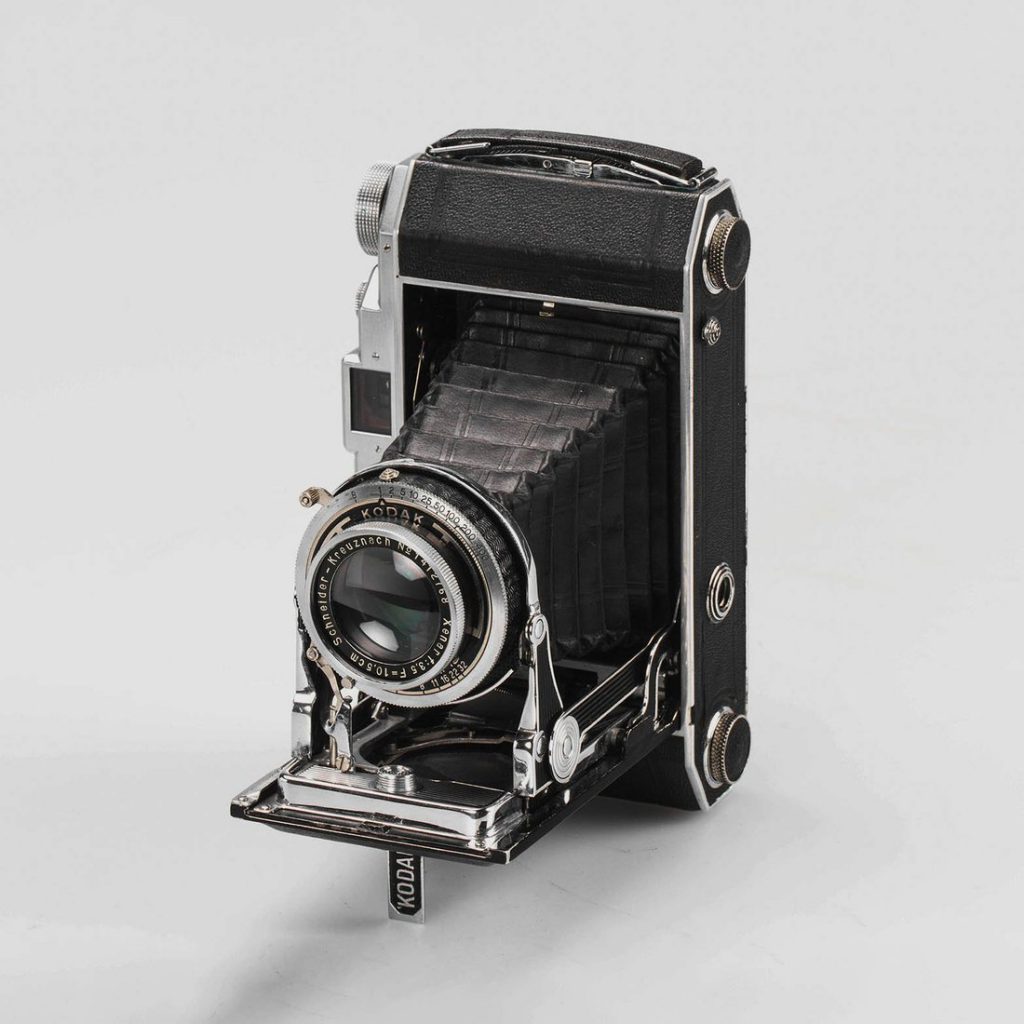
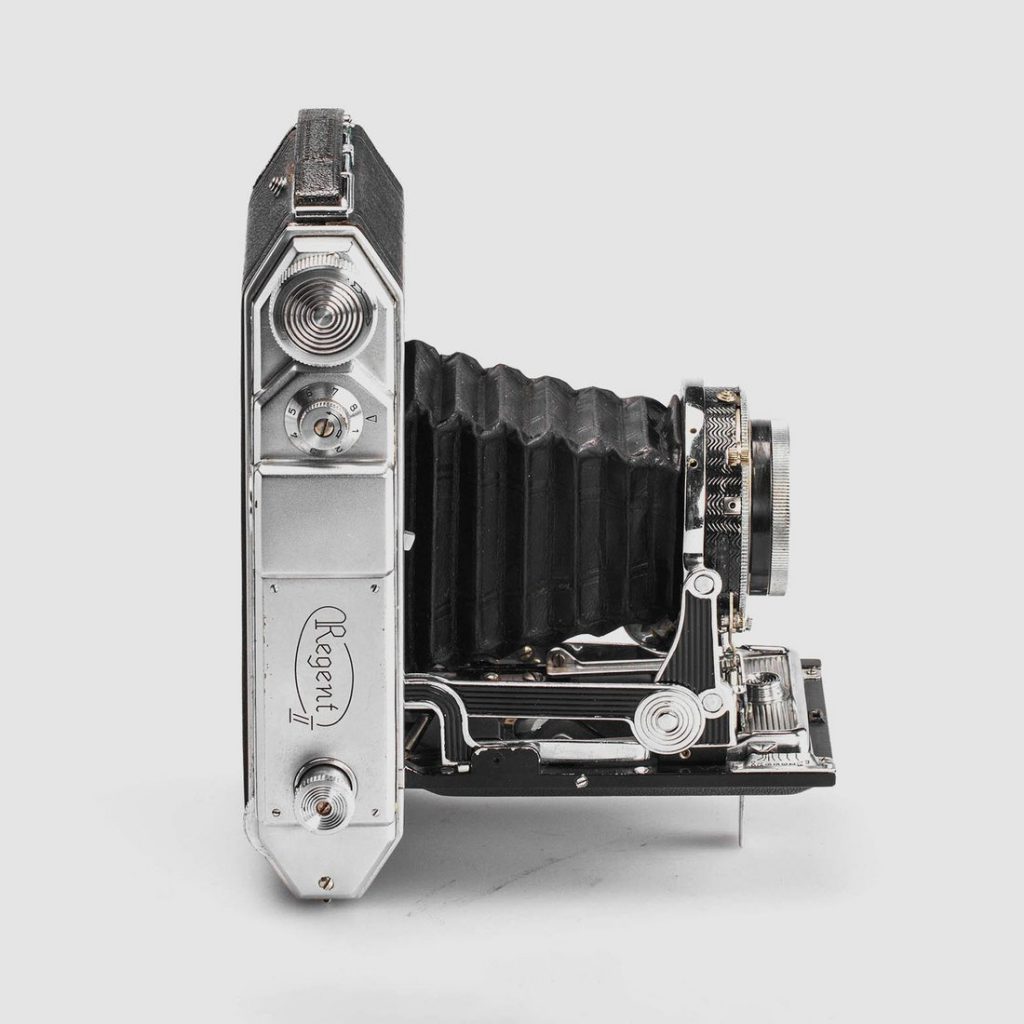
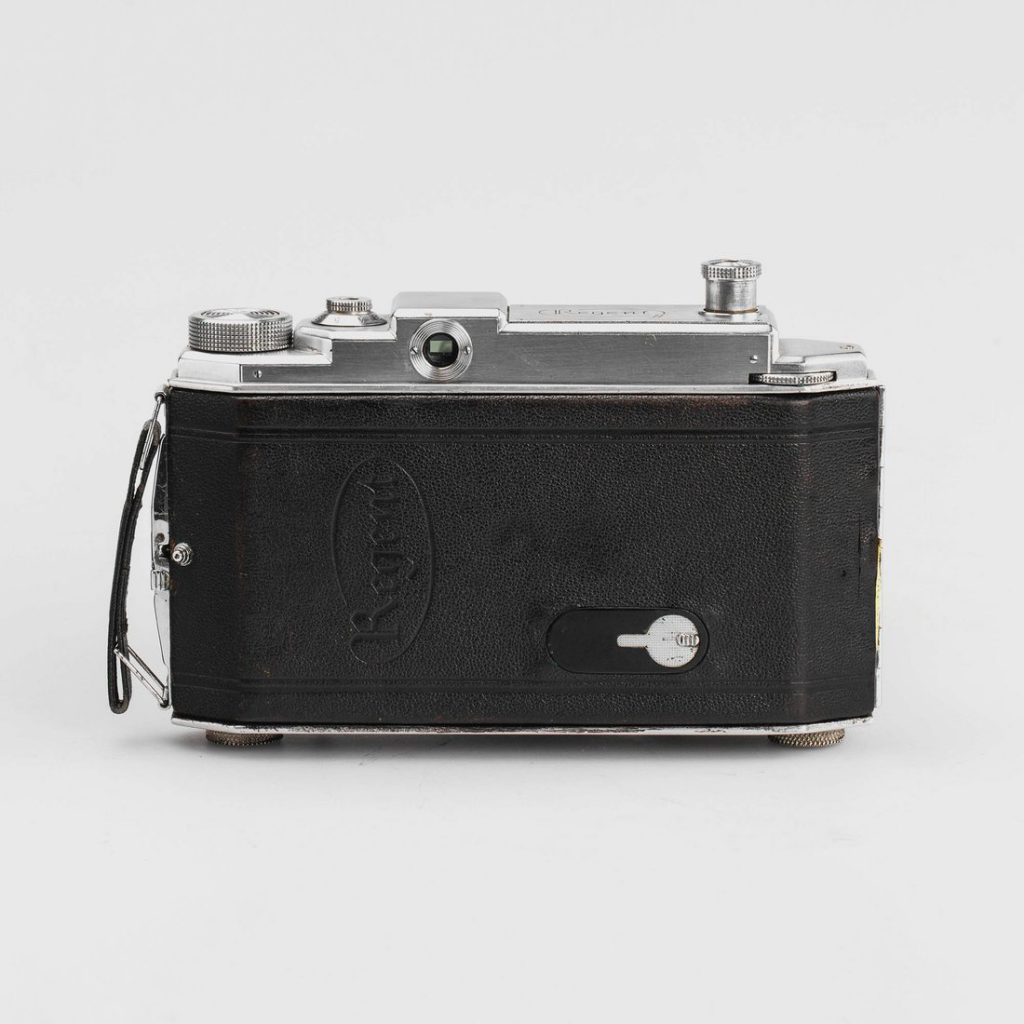








What a corker of a lens on this camera, Mike. The architectural subjects in your high res images are outstanding, beautifully lit and exposed. This is one of those cameras that I’ve read about so I know about it by reputation only. Regarding the models with feet markings, and given you can’t find any real evidence of it being exported to the USA, I’d guess it was likely intended for the UK market as the main contender.
Given the quality of the images, what scanner did you use?
The Schneider Xenar lens performed well. I’ve personally never thought Schneider lenses of this era to be any less excellent than Zeiss or other A-list lenses. The sample images in every review I do, were scanned using an Epson V550 flatbed scanner. It just does an OK job with 35mm, but does really well with medium format.
Hi Thankyou Mike for a great read and info on the Regent (camera one No: 877786) so very informative and so happy i found your article.
I purchased the Regent at auction to sell on not a keeper and was interested to understand more and to find the workings to open the back and side view finder It is excellent condition for age
Regards Vicki